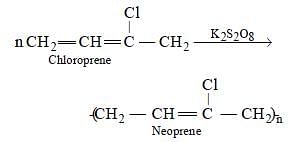31 Year NEET Previous Year Questions: Polymers (Old NCERT) - NEET MCQ
25 Questions MCQ Test Chemistry 31 Years NEET Chapterwise Solved Papers - 31 Year NEET Previous Year Questions: Polymers (Old NCERT)
An example of biopolymer is: [1994]
Bakelite is prepared by the reaction between: [1995]
| 1 Crore+ students have signed up on EduRev. Have you? Download the App |
In elastomer, intermolecular forces are: [1995]
Nylon 66 is a polyamide obtained by the reaction of: [1996]
Which one of the following is used to make "nonstick" cook-wares? [1997]
Natural rubber is a polymer of: [1999]
CF2 = CF2 is a unit of: [2000]
Which of the following is not correctly matched?
Vitamin B12 contains: [2003]
Acrilan is a hard, stimulated and a high melting material. Which of the following represents its structure ? [2003]
Which one of the following monomers gives the polymer neoprene on polymerization? [2003]
Which one of the following is a chain-growth polymer? [2004]
The monomer of the polymer: [2005]

Which one of the following polymers is prepared by condensation polymerisation? [2007]
Which one of the following statements is not true? [2008]
Structures of some common polymers are given. Which one is not correctly presented? [2009]
Which of the following structures represents neoprene polymer? [2010]
Of the following which one is classified as polyester polymer? [2011]
Which one of the following is not a condensation polymer ? [2012]
Which of the following statements is false? [2012]
Which one of the following sets forms the biodegradable polymer? [2012 M]
Which is the monomer of Neoprene in the following? [NEET 2013]
Nylon is an example of: [NEET 2013]
|
29 docs|49 tests
|
|
29 docs|49 tests
|











 : [2002]
: [2002]






 is a:
is a:
























